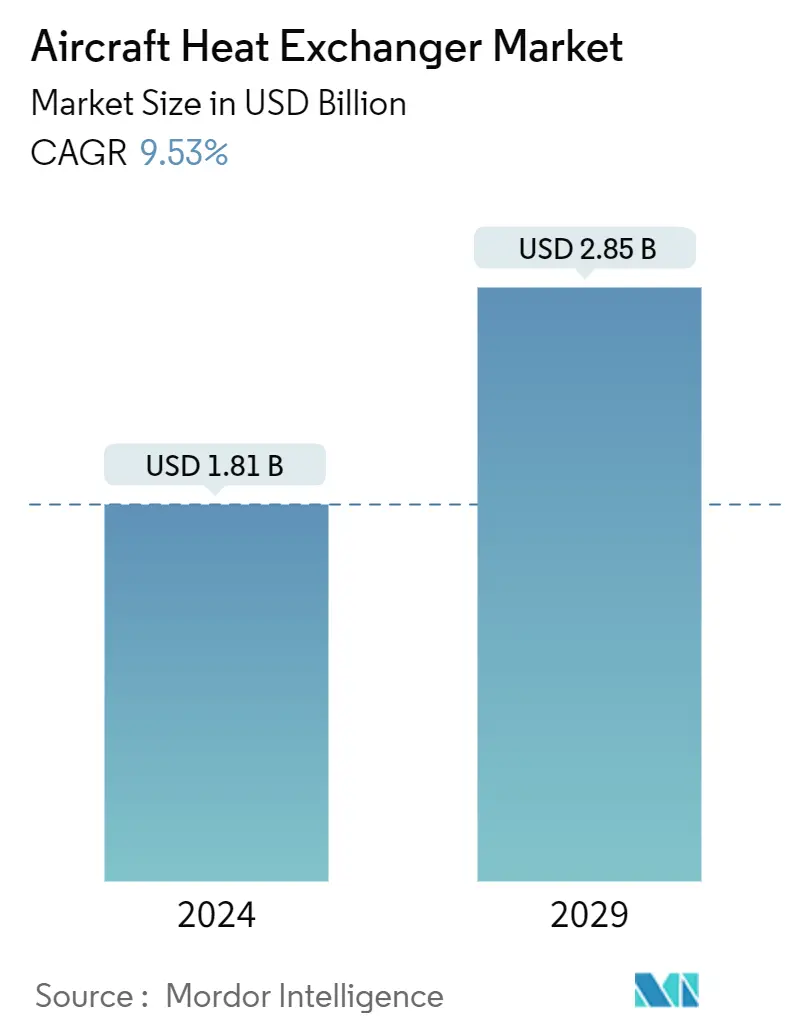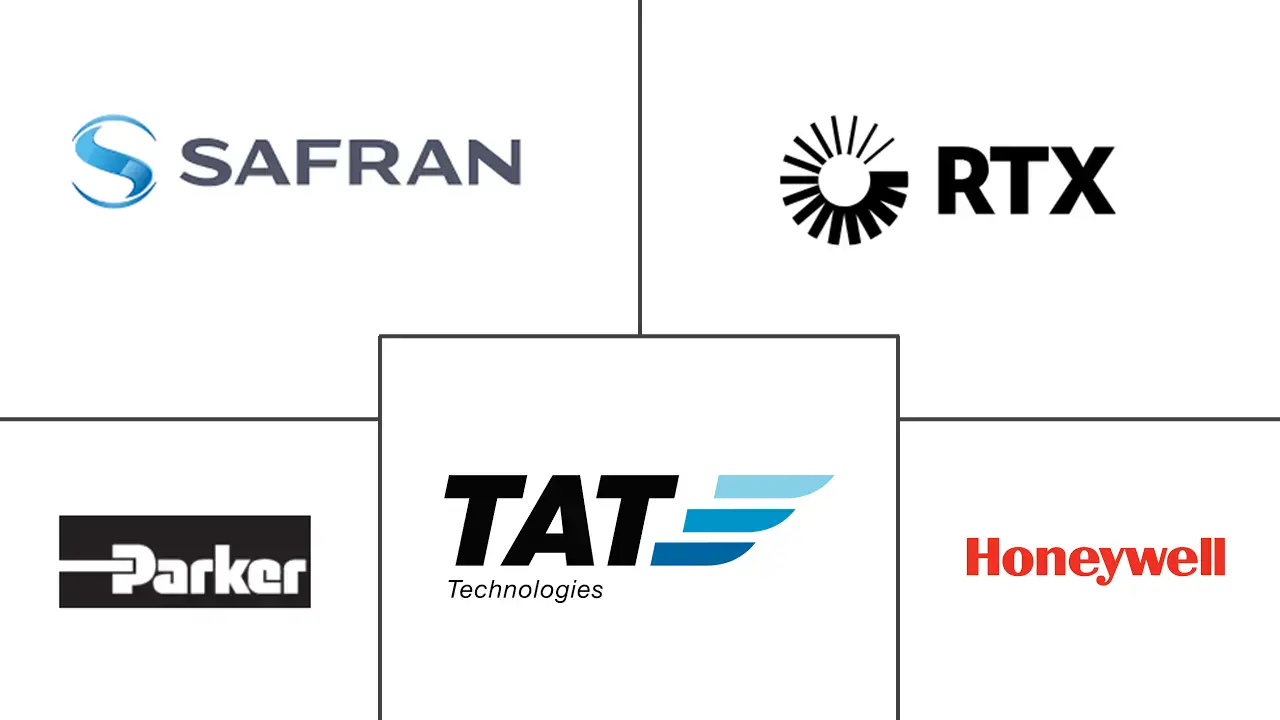Market Size of Aircraft Heat Exchanger Industry

| Study Period | 2019 - 2029 |
| Market Size (2024) | USD 1.81 Billion |
| Market Size (2029) | USD 2.85 Billion |
| CAGR (2024 - 2029) | 9.53 % |
| Fastest Growing Market | Asia-Pacific |
| Largest Market | North America |
Major Players
*Disclaimer: Major Players sorted in no particular order |
Aircraft Heat Exchanger Market Analysis
The Aircraft Heat Exchanger Market size is estimated at USD 1.81 billion in 2024, and is expected to reach USD 2.85 billion by 2029, growing at a CAGR of 9.53% during the forecast period (2024-2029).
- The global aircraft heat exchanger market witnessed unprecedented challenges due to the COVID-19 pandemic. The airlines had faced huge losses due to airport shutdowns, reduced air traffic, and supply chain disruptions that had led to a shortage of raw materials and delayed maintenance, repair, and overhaul operations. Research and development (R&D) of aircraft heat exchangers for military applications had been hampered due to a shortage of labor force. However, the market had showcased a strong recovery post-COVID due to increased aircraft deliveries and rising spending on aircraft maintenance, repair, and overhaul (MRO).
- Aircraft heat exchangers are used in aircraft engines, environmental control systems, and avionics that help to control heat and maintain the temperature of these systems. These are used to cool down hydraulic fluid and are located inside the fuel tank. The heat exchangers are used in all types of aircraft, including fixed-wing and rotary, and in many different aircraft systems.
- Advanced aircraft heat exchangers consist of thin wall thickness components such as tubes and fins to increase their thermodynamic efficiency. These systems are made up of heat-resistant metals such as aluminum, copper, titanium, and others for high-temperature applications. Increasing air traffic, rising expenditure on the procurement of advanced aircraft heat exchangers, and growing aircraft fleets worldwide drive the growth of the market.
Aircraft Heat Exchanger Industry Segmentation
A heat exchanger is a system used to transfer heat between a source and a working fluid. Heat exchangers are used in both heating and cooling processes. Aircraft heat exchangers are used in aircraft engines and environment control systems.
The aircraft heat exchanger market is segmented by type, platform, and geography. By Type, the market is segmented into plate-fin and flat tube. By platform, the market is segmented into fixed-wing, rotary-wing, and unmanned aerial vehicles (UAVs). The report also covers the market sizes and forecasts for the aircraft heat exchanger market in major countries across different regions. For each segment, the market size is provided in terms of value (USD).
| Type | |
| Plate-Fin | |
| Flat Tube |
| Platform | |
| Fixed-Wing | |
| Rotary-Wing | |
| Unmanned Aerial Vehicles (UAVs) |
| Geography | |||||||
| |||||||
| |||||||
| |||||||
| |||||||
|
Aircraft Heat Exchanger Market Size Summary
The aircraft heat exchanger market is poised for significant growth, driven by increasing air traffic and the rising demand for both commercial and military aircraft. These systems, essential for maintaining optimal temperatures in aircraft engines and other critical components, are experiencing heightened procurement due to the expanding global aircraft fleet. The market's recovery post-COVID-19 has been robust, with a surge in aircraft deliveries and increased spending on maintenance, repair, and overhaul operations. The fixed-wing segment, in particular, is expected to witness substantial growth, fueled by the demand for new aircraft and advancements in aviation technology. The market is characterized by the use of advanced materials and designs to enhance thermodynamic efficiency, catering to the needs of both fixed-wing and rotary aircraft.
Regionally, Asia-Pacific is anticipated to lead the market's growth, supported by substantial investments in the aviation sector and a burgeoning demand for new aircraft, especially in China and India. The region's defense expenditure and procurement of next-generation fighter jets further bolster market expansion. The market is semi-consolidated, with key players like Safran SA, TAT Technologies Ltd., RTX Corporation, Honeywell International Inc., and Parker Hannifin Corporation dominating the landscape. These companies are focusing on developing advanced heat exchanger systems to meet the evolving demands of the aviation industry. Collaborative efforts, such as those between General Atomics Aeronautical Systems Inc. and Conflux Technology, highlight the ongoing innovation and strategic partnerships shaping the market's future.
Aircraft Heat Exchanger Market Size - Table of Contents
-
1. MARKET DYNAMICS
-
1.1 Market Overview
-
1.2 Market Drivers
-
1.3 Market Restraints
-
1.4 Porter's Five Forces Analysis
-
1.4.1 Threat of New Entrants
-
1.4.2 Bargaining Power of Buyers/Consumers
-
1.4.3 Bargaining Power of Suppliers
-
1.4.4 Threat of Substitute Products
-
1.4.5 Intensity of Competitive Rivalry
-
-
-
2. MARKET SEGMENTATION
-
2.1 Type
-
2.1.1 Plate-Fin
-
2.1.2 Flat Tube
-
-
2.2 Platform
-
2.2.1 Fixed-Wing
-
2.2.2 Rotary-Wing
-
2.2.3 Unmanned Aerial Vehicles (UAVs)
-
-
2.3 Geography
-
2.3.1 North America
-
2.3.1.1 United States
-
2.3.1.2 Canada
-
-
2.3.2 Europe
-
2.3.2.1 United Kingdom
-
2.3.2.2 Germany
-
2.3.2.3 France
-
2.3.2.4 Russia
-
2.3.2.5 Rest of Europe
-
-
2.3.3 Asia Pacific
-
2.3.3.1 China
-
2.3.3.2 India
-
2.3.3.3 Japan
-
2.3.3.4 South Korea
-
2.3.3.5 Rest of Asia Pacific
-
-
2.3.4 Latin America
-
2.3.4.1 Brazil
-
2.3.4.2 Rest of Latin America
-
-
2.3.5 Middle East and Africa
-
2.3.5.1 Saudi Arabia
-
2.3.5.2 United Arab Emirates
-
2.3.5.3 South Africa
-
2.3.5.4 Rest of Middle East and Africa
-
-
-
Aircraft Heat Exchanger Market Size FAQs
How big is the Aircraft Heat Exchanger Market?
The Aircraft Heat Exchanger Market size is expected to reach USD 1.81 billion in 2024 and grow at a CAGR of 9.53% to reach USD 2.85 billion by 2029.
What is the current Aircraft Heat Exchanger Market size?
In 2024, the Aircraft Heat Exchanger Market size is expected to reach USD 1.81 billion.

